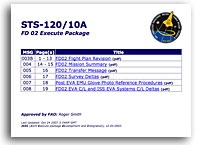NASA STS-120 Execute Package FD 11

FD 10 MMT Summary
The MMT met to review mission priorities, mission progress and orbiter status. The MMT and the ground team greatly appreciate your patience with the additional day that is required to prepare and validate the procedures that you will use during EVA 4, now scheduled for FD12. The MMT did not receive a formal briefing on the task content of EVA 4. This detailed review was scheduled to occur just after the MMT meeting.
Robotic Operations for EVA 4: The MMT received a high level overview of the sequence of robotic events, currently planned for FD 11, which set up the initial conditions for EVA4. At the time of the MMT, it was estimated that the OBSS would remain unpowered for a total of 12 hours. The first 4 hours pertain to the timeframe where the MT/SSRMS has grappled the OBSS and is translating from WS 3 to WS 8. The remaining 8 hours pertain to the timeframe associated with EVA 4. Post-MMT, the operations team further refined the plan. OBSS will now be handed off to SRMS prior to MT translation to WS 8, and then handed back to SSRMS on the morning of the EVA. This will minimize the unpowered time to only that required to support EVA 4 (~ 8 hrs).
Attitude Timeline – The MMT reviewed the requirements that the mission operations team should use to determine trade-offs for returning from the current +XVV attitude to a more desirable -XVV attitude for MMOD risk optimization. The current attitude timeline is optimized for the expected lighting associated with EVA 4, which the MMT recognizes and supports as the first priority. There are many integrated constraints that must be balanced and the Mission Operations team will consider all of them before implementing changes to the timeline plan.
OBSS Grapple Position Anomaly: The Orbiter Project Office was able to identify the root cause of the OBSS grapple position anomaly that was initially seen on FD2. The problem was determined to be a blanket at the SRMS elbow joint (Figure 1) that was improperly installed, which affected the position encoder mechanism on that joint. This encoder position issue is exacerbated when the SRMS elbow joint is at an acute angle, which is why this problem appeared when the SRMS initially grappled the OBSS. During the course of the FD2 inspection operations, a data review shows that the improperly installed blanket has relieved and is no longer inducing a bias in the encoder readings. Under worse case assumptions, if this encoder positioning problem re-occurs, this problem will not cause any structural clearance concerns for late inspection.








